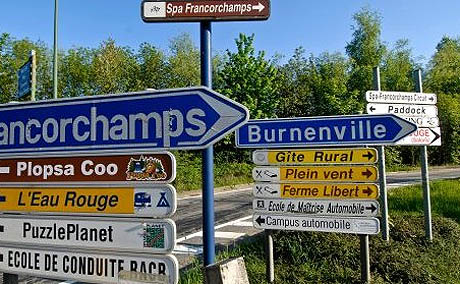


30/08/2012
NEWS STORY
 |
The Belgian Grand Prix is the first of the final nine races, which fly at the sport in an incredible 13 frenetic weeks. As Renault Sport F1 engine engineer David Lamb explains, there is perhaps no greater challenge on the calendar than the one facing F1's power units at the legendary Spa-Francorchamps.
"The challenge of Spa really is Eau Rouge and Raidillon," he admits. "The compression at the bottom of Eau Rouge isn't a massive problem as the vertical g-forces squash everything in the car down, so all the fluids are pushed down. This ensures that the pick-ups at the bottom of the oil and fuel tanks are covered. The problem comes at the crest at Raidillon, when the vertical G makes the car go light and your stomach feels like it's going to come out of your mouth. That's the biggest problem, because the vertical G lifts the fluids up and that can expose the fuel pump and the oil system entry.
"That means that you might not get the fuel or oil at that point and that can be a major problem. The fuel system is generally a bit easier to deal with because you can pressurise it quite easily, but the oil system is the issue. The shift in vertical G can lift oil off the top of the pump and there were times in the past when it was a real reliability risk and challenge. Without oil the engine won't last very long.
"To give you some idea of how critical keeping the oil in the system is, when you hit Raidillon you'll already be in seventh gear. The pistons are moving up and down over 250 times per second at this point. You get to the top of the hill out of Eau Rouge and then you have the vertical lift. With no oil, your engine will last for between half a second and a second, maximum. That's how crucial oil system management is.
"This weekend you have to know what you can go down to in terms of oil levels, and in the race you may go a little over that to avoid any risk. We experience something similar at Maggotts and Becketts at Silverstone, or at Turn 8 in Turkey, but that's lateral G where fuel or oil gets pushed to the side. Having oil lifted up is a unique feature of Spa.
"Of course, fuel delivery is also critical as you don't want to lose performance at the top of the hill, or you'll be a sitting duck to your rivals behind on the long run up to Les Combes. But in terms of losing an engine, it's all about the oil system at Raidillon."
The challenge however doesn't simply come from the elevation changes at Spa. The track also features some challenging corners, which place lateral effect on the car, engine and fluids.
"While Eau Rouge and Raidillon give us compression and vertical lift, there is also an area of lateral G that we have to take into consideration. Blanchimont is a relatively large radius corner so shouldn't affect us too much, but Pouhon can be hard to get right. The double left hander, downhill, much like Turn 8 in Turkey, shifts the fuel and oil over to the right hand side of the car so you have to take it into consideration and compensate. It's easy to get light through that corner and have drop outs. You have pick up pumps all around for fuel, but only really one for the oil, which is why the oil system is a more complicated thing to get sorted under these type of G forces."
Allied to all this, is the fact that Spa sees the greatest change in altitude at any circuit on the F1 calendar.
"The air pressure really does change a lot at Spa. It doesn't affect us too much but it is fascinating to look at the data. Most of us use a Closed-Loop Fuelling Strategy (CLF) and with that you monitor the correction that you're putting into the engine. Normally it should be at 100% if you've got your fuel map right, but at Spa it oscillates between 100 and little bit less than 99% because at the top of the hill the air pressure is less. You are looking at a 100 metre elevation change across the lap, which is pretty immense. That accounts for a 10 or 12mbar pressure change and also means that the drivers have less power at the top of the hill than they do at the bottom. It also means you need less fuel than at the bottom of the hill. Looking at the data you can notice it very easily."
Spa then, is perhaps the greatest challenge with which to return from the summer break. To be successful here then requires not just a driver at the peak of his performance, but the very same from his engine.
"From La Source to Les Combes is immense. You are in seventh gear for so long, high revs for so long, and so from my perspective I think it is a bigger challenge than anywhere, even Monza. You are pushing the car up that hill… and when you hear it on the dyno and you hear how long it is in top gear at high revs, and you think it's going to blow! You're doing that three times a lap, and in seventh gear for almost 40% of the lap. Spa is truly the greatest challenge an engine will face all season."